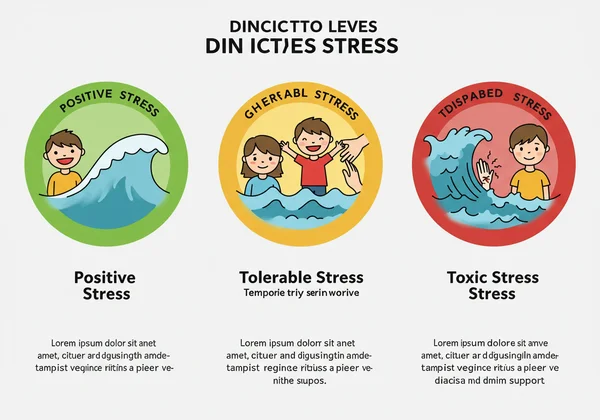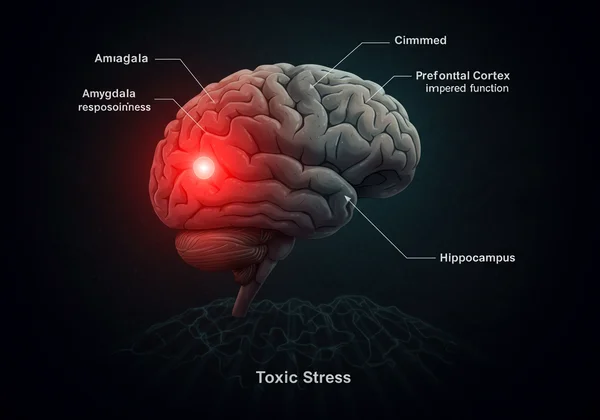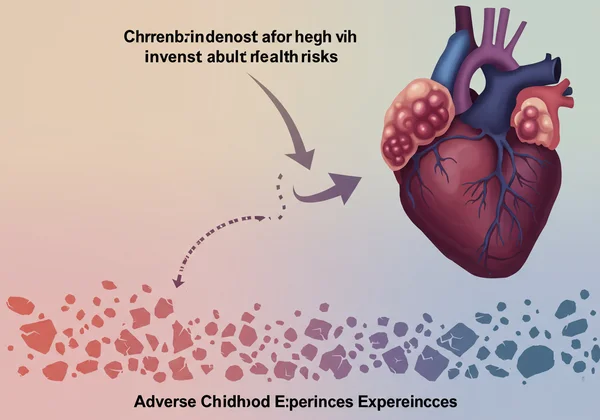Tindak Balas Tekanan Toksik: Bagaimana Ujian ACE Mendedahkan Kesan pada Otak & Badan Anda
Pernahkah anda berasa seperti badan anda terperangkap dalam keadaan berlebihan, bertindak balas terhadap tekanan kecil dengan kekuatan yang melampau? Adakah anda tertanya-tanya mengapa corak kebimbangan atau masalah kesihatan tertentu berterusan, tidak kira apa yang anda cuba? Jawapannya mungkin terletak bukan pada masa kini anda, tetapi pada masa lalu anda, melalui proses biologi yang kuat yang dikenali sebagai tindak balas tekanan toksik. Memahami hubungan ini adalah langkah pertama ke arah mendapatkan kembali kesejahteraan anda. Jadi, apakah tindak balas tekanan toksik, dan bagaimana Pengalaman Negatif Kanak-Kanak (ACEs) mencetuskannya?
Artikel ini akan meneroka sains di sebalik tekanan toksik, menjelaskan bagaimana ia secara fizikal membentuk semula otak dan badan anda, dan bagaimana ujian ACE boleh membimbing penyembuhan anda. Lebih penting lagi, ia akan menunjukkan kepada anda bahawa memahami masa lalu anda melalui alat seperti ujian ACE dalam talian adalah langkah penting ke arah penyembuhan dan membina daya tahan. Pengetahuan adalah langkah pertama yang kuat dalam perjalanan anda menuju penemuan diri.
Memahami Tekanan Toksik: Lebih Daripada Sekadar "Tekanan"
Kita menggunakan perkataan "tekanan" untuk menggambarkan segala-galanya daripada tarikh akhir yang menghampiri hingga kesesakan lalu lintas. Walau bagaimanapun, tidak semua tekanan dicipta sama. Dari perspektif psikologi dan biologi, tekanan terbahagi kepada tiga kategori yang berbeza. Mengenal pasti perbezaan ini adalah kunci untuk memahami mengapa ACEs mempunyai kesan yang mendalam dan berkekalan terhadap kesihatan kita.
Membezakan Tekanan Toksik daripada Tekanan Harian & Boleh Diterima
Untuk memahami keterukan tekanan toksik, mari kita tentukan dahulu jenis-jenis tekanan yang lain. Tekanan positif adalah bahagian normal dan penting dalam perkembangan yang sihat. Ia adalah peningkatan jangka pendek dalam kadar denyutan jantung dan tahap hormon yang kita rasai sebelum pembentangan besar atau temu janji pertama. Jenis tekanan ini memberi motivasi dan membantu kita berkembang.
Tekanan yang boleh diterima adalah lebih serius. Ia diaktifkan oleh peristiwa kehidupan yang signifikan seperti kehilangan orang yang disayangi, penyakit serius, atau bencana alam. Walaupun tindak balas tekanan badan lebih sengit, ia kekal terhad masa. Yang penting, dengan adanya hubungan sokongan dengan orang dewasa yang boleh melindungi kanak-kanak, otak dan organ lain boleh pulih daripada kesan yang mungkin merosakkan.
Tekanan toksik, bagaimanapun, adalah berbeza. Ia berlaku apabila seorang kanak-kanak mengalami kesukaran yang kuat, kerap, atau berpanjangan—seperti penderaan fizikal atau emosi, pengabaian kronik, atau penyalahgunaan bahan oleh penjaga—tanpa sokongan dewasa yang mencukupi. Di sinilah kesan ujian trauma ACE menjadi jelas. Pengaktifan berterusan sistem tindak balas tekanan, tanpa sebarang kelegaan, mula melemahkan asas badan.

Rentetan Fisiologi: Bagaimana Badan Anda Bertindak Balas terhadap Ancaman Kronik
Apabila anda mengesan ancaman, sistem penggera otak anda—amigdala—mencetuskan banjir hormon tekanan seperti kortisol dan adrenalin. Tindak balas "lawan atau lari" ini adalah mekanisme kelangsungan hidup jangka pendek yang cemerlang. Jantung anda berdegup kencang, otot anda menegang, dan deria anda menajam, mempersiapkan anda untuk menghadapi bahaya.
Dalam persekitaran tekanan toksik, penggera ini tidak pernah dimatikan. Badan terdedah secara berterusan kepada hormon tekanan selama berbulan-bulan atau bahkan bertahun-tahun. Keadaan kewaspadaan tinggi yang berterusan ini membawa kepada apa yang saintis sebut sebagai "beban alostatik" yang tinggi—kehausan kumulatif pada badan dan otak. Ia seperti menghidupkan enjin kereta pada zon merah terlalu lama; akhirnya, bahagian-bahagian mula rosak. Ini adalah laluan biologi yang menghubungkan kesukaran awal kepada masalah kesihatan di kemudian hari.
Tekanan Toksik Kanak-Kanak & Perkembangan Otak
Otak paling terdedah kepada kesan tekanan toksik semasa awal kanak-kanak, tempoh pertumbuhan dan perkembangan yang pesat. Seni bina otak yang sedang berkembang dibina dari bawah ke atas, dan tekanan kronik boleh mengganggu proses pembinaan ini, mewujudkan asas yang goyah untuk semua pembelajaran, tingkah laku, dan kesihatan masa depan. Ini menjadikan pemahaman sejarah peribadi anda melalui ujian skor ACE sebagai alat yang tidak ternilai untuk kesedaran diri.
Penyambungan Semula Otak: Kesan pada Amigdala, Korteks Prefrontal & Hippocampus
Pendedahan kronik kepada hormon tekanan secara langsung mempengaruhi kawasan utama otak yang bertanggungjawab untuk pembelajaran, ingatan, dan peraturan emosi.
-
Amigdala (Pusat Ketakutan): Amigdala menjadi sangat responsif. Ini bermakna otak kanak-kanak menjadi terprogram untuk mengesan ancaman di mana-mana, menyebabkan keadaan kebimbangan dan ketakutan yang berterusan, walaupun dalam situasi yang selamat.
-
Korteks Prefrontal (Pusat Kawalan): Kawasan ini, bertanggungjawab untuk fungsi eksekutif seperti membuat keputusan, kawalan impuls, dan fokus, boleh terbantut. Tekanan toksik mengganggu keupayaannya untuk mengawal emosi dan memikirkan akibatnya.
-
Hippocampus (Pusat Memori): Hippocampus adalah penting untuk pembelajaran dan pembentukan ingatan. Tahap kortisol yang tinggi boleh mengecutkan kawasan otak ini, mengganggu keupayaan untuk belajar dan mewujudkan kesukaran dengan ingatan semula.

Gema Kekal: Bagaimana Tekanan Awal Membentuk Fungsi Dewasa
Perubahan neurologi ini tidak hilang begitu sahaja apabila seseorang meninggalkan persekitaran kanak-kanak yang sukar. Ia mencipta gema yang berkekalan yang boleh muncul pada usia dewasa sebagai kesukaran mengurus emosi, cabaran dalam membentuk hubungan yang sihat, dan kerentanan yang lebih tinggi terhadap kebimbangan dan kemurungan. Memahami hubungan ini bukan tentang menyalahkan; ia adalah tentang mengenali kesan biologi pengalaman anda. Ia memberikan penjelasan saintifik mengapa anda mungkin berasa seperti yang anda rasakan, satu langkah penting sebelum anda boleh mengambil ujian ACE dan mula sembuh.
Sains Di Sebalik ACEs dan Tekanan Toksik
Hubungan antara Pengalaman Negatif Kanak-Kanak dan tekanan toksik bukan sekadar teori; ia adalah penemuan kesihatan awam yang disahkan secara saintifik. Pemahaman ini membantu kita membingkai semula trauma, mengalihkan perbualan daripada penghakiman watak kepada penjelasan saintifik, menawarkan pandangan yang lebih jelas dan penuh belas kasihan tentang perkembangan manusia.
Hubungan Kajian ACE CDC-Kaiser Permanente
Kajian Pengalaman Negatif Kanak-Kanak (ACE) CDC-Kaiser Permanente yang groundbreaking pada tahun 1990-an adalah yang pertama secara saintifik menghubungkan kesukaran zaman kanak-kanak dengan hasil kesihatan dewasa. Penyelidik menyoal lebih 17,000 orang dewasa tentang pendedahan mereka kepada 10 jenis trauma kanak-kanak tertentu. Mereka menemui hubungan tindak balas dos secara langsung antara bilangan ACE yang dimiliki seseorang dan risiko mereka terhadap pelbagai masalah kesihatan beberapa dekad kemudian.
Kajian itu mendedahkan bahawa ACEs sangat biasa dan kesannya adalah kumulatif. Tekanan toksik adalah mekanisme biologi yang menjelaskan penemuan ini. Soal selidik ACEs, seperti yang ditawarkan di platform kami, adalah aplikasi langsung penyelidikan penting ini, membolehkan individu mengukur pendedahan mereka kepada kesukaran tertentu ini. Mengetahui skor anda dari ujian ACE boleh menjadi langkah pertama untuk menghubungkan titik-titik dalam kehidupan anda sendiri.
Melangkaui Psikologi: Menghubungkan Tekanan Toksik kepada Risiko Kesihatan Fizikal Kronik
Selama bertahun-tahun, kita melihat kesihatan mental dan fizikal sebagai berasingan. Sains tekanan toksik membuktikan bahawa ia saling berkait rapat. Keradangan kronik dan disregulasi hormon yang disebabkan oleh tindak balas tekanan yang berpanjangan menyumbang secara langsung kepada punca utama kematian dan hilang upaya pada usia dewasa.
Individu dengan skor ACE yang tinggi mempunyai risiko yang meningkat secara signifikan untuk keadaan seperti penyakit jantung, strok, kanser, diabetes, dan penyakit autoimun. Ini bukan disebabkan oleh kegagalan peribadi; ia adalah akibat fisiologi daripada sistem yang berlebihan beban. Dengan mengambil ujian Pengalaman Negatif Kanak-Kanak, anda memperoleh pandangan tentang potensi risiko kesihatan anda, memperkasakan anda untuk melakukan penjagaan proaktif dan pencegahan dengan doktor anda.

Membina Daya Tahan: Menyembuhkan Trauma Kanak-Kanak dan Mengurangkan Kesan ACE
Mempelajari tentang tekanan toksik dan skor ACE yang tinggi boleh terasa membebankan, tetapi mesej yang paling penting adalah harapan. Otak sangat plastik, dan badan ingin sembuh. Masa lalu anda tidak perlu menentukan masa depan anda. Membina daya tahan adalah proses mengatasi kesan tekanan toksik dan membentuk laluan baharu menuju kesejahteraan.
Kuasa Faktor Pelindung & Hubungan Sokongan
Faktor pelindung tunggal yang paling kuat terhadap kesan tekanan toksik adalah hubungan yang selamat, stabil, dan memelihara dengan orang dewasa yang penyayang. Walaupun ini tidak wujud semasa kanak-kanak, tidak pernah terlambat untuk membina hubungan ini. Terapi, persahabatan yang menyokong, dan penglibatan komuniti boleh menyediakan keselamatan hubungan yang diperlukan untuk membantu sistem saraf mengawal selia dan menyembuhkan. Hubungan ini menjadi pengawal selia luaran, membantu sistem dalaman kita mencari ketenangan dan keselamatan.

Amalan Minda-Badan & Pendekatan Berinformasi Trauma untuk Regulasi
Oleh kerana tekanan toksik wujud dalam badan, penyembuhan memerlukan amalan yang menangani realiti fisiologi ini. Teknik minda-badan adalah penting untuk meredakan sistem penggera badan yang terlalu aktif.
- Kesedaran dan Meditasi: Amalan ini membantu melatih korteks prefrontal untuk mengawal amigdala dengan lebih baik, mengurangkan kebimbangan dan menggalakkan ketenangan.
- Yoga dan Pergerakan: Pergerakan yang lembut dan sedar badan boleh membantu melepaskan ketegangan fizikal yang tersimpan dan memulihkan rasa selamat dalam diri sendiri.
- Terapi Berinformasi Trauma: Modaliti seperti Desensitisasi dan Pemprosesan Pergerakan Mata (EMDR) atau Pengalaman Somatik membantu memproses ingatan traumatik yang "terperangkap" dalam sistem saraf.
Memahami sejarah anda adalah langkah pertama. Adakah anda bersedia untuk mengetahui skor anda?
Memahami Tekanan Toksik: Langkah Pertama Anda Ke Arah Penyembuhan & Pemerkasaan
Tindak balas tekanan toksik adalah hubungan saintifik tersembunyi antara cabaran masa lalu kita dan realiti masa kini kita. Ia adalah kisah biologi bagaimana Pengalaman Negatif Kanak-Kanak boleh menjadi tertanam secara fizikal dalam otak dan badan kita, mempengaruhi kesihatan dan kesejahteraan kita selama beberapa dekad. Tetapi cerita ini tidak perlu berakhir di situ.
Dengan memahami proses ini, anda beralih daripada menyalahkan diri sendiri kepada belas kasihan diri. Anda memperoleh rangka kerja untuk memahami pengalaman anda dan peta jalan untuk bergerak ke hadapan. Pemerkasaan sebenar berkembang daripada pemahaman seperti ini. Mengambil penilaian sulit berasaskan sains adalah langkah pertama yang berani dalam perjalanan penemuan diri dan penyembuhan yang mendalam.
Kami menjemput anda untuk mengambil langkah itu hari ini. Lawati platform sulit kami untuk mengambil ujian ACE percuma dan mula membuka kunci pandangan yang akan membantu anda membina masa depan yang lebih sihat dan berdaya tahan.
Soalan Lazim
Apakah 10 ACEs dan bagaimana ia membawa kepada tekanan toksik?
10 ACEs teras yang dikenal pasti dalam kajian CDC-Kaiser termasuk tiga jenis penderaan (fizikal, emosi, seksual), dua jenis pengabaian (fizikal, emosi), dan lima jenis disfungsi isi rumah (perpisahan/perceraian ibu bapa, keganasan rumah tangga, penyalahgunaan bahan, penyakit mental, dan ahli isi rumah yang dipenjarakan). Apabila pengalaman ini kerap, berpanjangan, dan berlaku tanpa hubungan sokongan, ia mengaktifkan sistem tindak balas tekanan badan berulang kali, membawa kepada kesan merosakkan tekanan toksik.
Bolehkah anda pulih daripada kesan skor ACE yang tinggi dan tekanan toksik?
Sudah tentu. Otak dan badan manusia mempunyai kapasiti penyembuhan yang luar biasa. Walaupun skor ACE yang tinggi menunjukkan risiko yang lebih tinggi untuk masalah kesihatan tertentu, ia bukanlah nasib yang tidak dapat dielakkan. Melalui hubungan sokongan, terapi berinformasi trauma, pilihan gaya hidup sihat, dan amalan minda-badan, individu boleh membina daya tahan dan mengurangkan dengan ketara kesan jangka panjang tekanan toksik.
Apakah skor ACE saya dan di mana saya boleh mengambil ujian ACE dalam talian?
Skor ACE anda adalah nombor dari 0 hingga 10 yang mencerminkan berapa banyak daripada 10 jenis Pengalaman Negatif Kanak-Kanak yang anda alami sebelum hari lahir anda yang ke-18. Anda boleh mengetahui skor ACE anda dengan mengambil ujian ACE yang sulit dan percuma berdasarkan kajian ACE asal. Platform kami menawarkan versi yang selamat dan mudah digunakan, memberikan anda skor segera dan tafsiran yang jelas untuk membantu anda mengambil langkah pertama dalam perjalanan pemahaman anda.
Adakah kematian ibu bapa merupakan ACE atau punca tekanan toksik?
Walaupun kematian ibu bapa adalah peristiwa yang sangat tertekan dan traumatik, ia bukan salah satu daripada 10 ACEs asal yang diukur oleh ujian standard. Walau bagaimanapun, ia sememangnya boleh menjadi sumber tekanan yang boleh diterima atau bahkan toksik, terutamanya jika penjaga yang masih hidup tidak dapat memberikan sokongan yang diperlukan untuk membantu kanak-kanak itu menghadapi dan berasa selamat. Konteks dan sistem sokongan di sekeliling peristiwa itulah yang menentukan kesan jangka panjangnya.